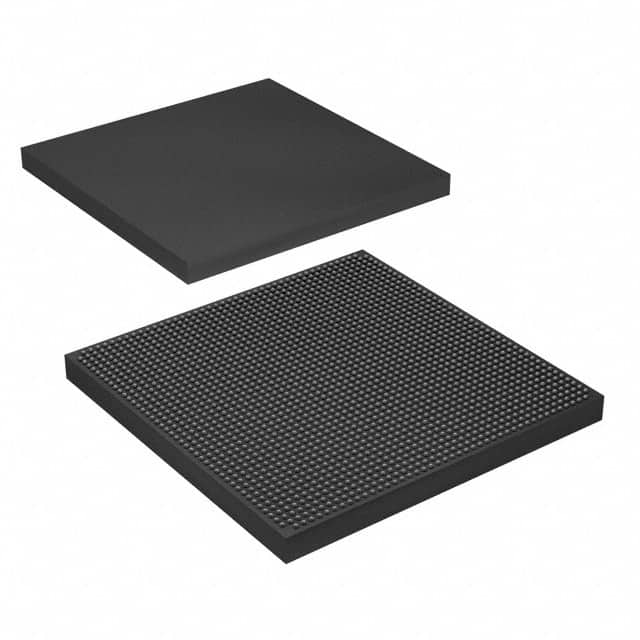Consulte las especificaciones para obtener detalles del producto.

5SGXEA7N2F45I2L
Product Overview
Category
The 5SGXEA7N2F45I2L belongs to the category of Field Programmable Gate Arrays (FPGAs).
Use
FPGAs are integrated circuits that can be programmed and reprogrammed to perform various digital functions. The 5SGXEA7N2F45I2L is specifically designed for high-performance applications.
Characteristics
- High-performance FPGA with advanced features
- Large capacity and high-speed processing capabilities
- Flexible and reconfigurable design
- Low power consumption
- Robust and reliable performance
Package
The 5SGXEA7N2F45I2L comes in a compact package, suitable for integration into electronic systems.
Essence
The essence of the 5SGXEA7N2F45I2L lies in its ability to provide a customizable and high-performance solution for complex digital designs.
Packaging/Quantity
The 5SGXEA7N2F45I2L is typically packaged individually and is available in various quantities depending on the customer's requirements.
Specifications
- FPGA Family: Stratix V
- Logic Elements: 476,000
- Embedded Memory: 34,816 Kbits
- DSP Blocks: 1,288
- Maximum User I/Os: 1,040
- Operating Voltage: 1.0V
- Operating Temperature: -40°C to 100°C
- Package Type: F45
- Package Pins: 1,152
Detailed Pin Configuration
For a detailed pin configuration diagram of the 5SGXEA7N2F45I2L, please refer to the manufacturer's datasheet or documentation.
Functional Features
The 5SGXEA7N2F45I2L offers a range of functional features, including:
- High-speed data processing
- Support for various communication protocols
- On-chip memory resources
- Flexible I/O interfaces
- Built-in security features
- Clock management capabilities
Advantages and Disadvantages
Advantages
- High-performance capabilities
- Flexibility and reconfigurability
- Low power consumption
- Robust and reliable operation
- Suitable for complex digital designs
Disadvantages
- Higher cost compared to other programmable logic devices
- Steeper learning curve for programming and design
Working Principles
The 5SGXEA7N2F45I2L operates based on the principles of field-programmable gate arrays. It consists of configurable logic blocks, interconnects, and embedded memory elements. The device can be programmed using hardware description languages (HDL) or graphical tools to define the desired functionality.
Detailed Application Field Plans
The 5SGXEA7N2F45I2L finds applications in various fields, including:
- Telecommunications: High-speed data processing, signal processing, and network infrastructure.
- Aerospace and Defense: Radar systems, avionics, and secure communications.
- Industrial Automation: Control systems, robotics, and machine vision.
- Medical Equipment: Imaging systems, diagnostic devices, and patient monitoring.
- Automotive: Advanced driver-assistance systems (ADAS), infotainment, and engine control.
Detailed and Complete Alternative Models
- 5SGXEA7N2F45C2: Similar to 5SGXEA7N2F45I2L but with different package type.
- 5SGXEA7N2F45M2: Similar to 5SGXEA7N2F45I2L but with additional features for specific applications.
- 5SGXEA7N2F45E2: Similar to 5SGXEA7N2F45I2L but optimized for power efficiency.
These alternative models offer similar capabilities and can be considered based on specific project requirements.
Note: The content provided above is a sample structure for an encyclopedia entry and may not reflect the actual specifications or details of the mentioned product.
Enumere 10 preguntas y respuestas comunes relacionadas con la aplicación de 5SGXEA7N2F45I2L en soluciones técnicas
Sure! Here are 10 common questions and answers related to the application of 5SGXEA7N2F45I2L in technical solutions:
Q: What is the 5SGXEA7N2F45I2L FPGA used for? A: The 5SGXEA7N2F45I2L is a Field-Programmable Gate Array (FPGA) that can be used for various applications such as high-performance computing, networking, and digital signal processing.
Q: What are the key features of the 5SGXEA7N2F45I2L FPGA? A: Some key features include a large number of logic elements, high-speed transceivers, embedded memory blocks, and support for various communication protocols.
Q: How can the 5SGXEA7N2F45I2L FPGA be programmed? A: The FPGA can be programmed using hardware description languages (HDLs) such as VHDL or Verilog, or through graphical programming tools like Quartus Prime.
Q: Can the 5SGXEA7N2F45I2L FPGA be used for real-time image processing? A: Yes, the FPGA's high-performance capabilities make it suitable for real-time image processing tasks, such as video compression, object recognition, and computer vision algorithms.
Q: Is the 5SGXEA7N2F45I2L FPGA compatible with industry-standard interfaces? A: Yes, the FPGA supports various industry-standard interfaces like PCIe, Ethernet, USB, HDMI, and DDR memory, making it easy to integrate into existing systems.
Q: Can the 5SGXEA7N2F45I2L FPGA be used for cryptographic applications? A: Absolutely, the FPGA's high-speed transceivers and embedded memory blocks make it suitable for implementing cryptographic algorithms like AES, RSA, or SHA.
Q: What kind of development board is available for the 5SGXEA7N2F45I2L FPGA? A: The 5SGXEA7N2F45I2L can be used with development boards like the Terasic DE5-Net, which provide additional peripherals and interfaces for prototyping and testing.
Q: Can the 5SGXEA7N2F45I2L FPGA be used in safety-critical applications? A: Yes, the FPGA supports various safety features like error correction codes (ECC), triple modular redundancy (TMR), and built-in self-test (BIST) capabilities, making it suitable for safety-critical applications.
Q: Is the 5SGXEA7N2F45I2L FPGA power-efficient? A: The power efficiency of the FPGA depends on the specific design and utilization. However, it offers power-saving features like dynamic power management and clock gating to optimize power consumption.
Q: Are there any reference designs or IP cores available for the 5SGXEA7N2F45I2L FPGA? A: Yes, Intel (formerly Altera) provides a wide range of reference designs and intellectual property (IP) cores that can be used with the 5SGXEA7N2F45I2L FPGA, including communication protocols, image processing algorithms, and more.
Please note that the specific details and answers may vary depending on the context and requirements of the technical solution.

